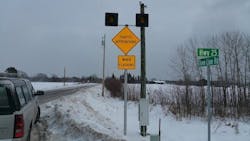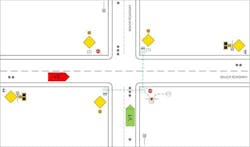By: Victor Lund, P.E. and Jon Jackels, P.E.
Rural intersections continue to be the second leading contributor of serious crashes in Minnesota.
Specifically, these crashes typically occur when drivers on a minor road move into the intersection with an insufficient gap between vehicles on a major road, resulting in right-angle crashes. In Minnesota, for the five-year period 2011-2015, right-angle crashes represented the second-highest crash type for fatal and serious injury crashes, at 20%. For reference, the leading crash type in these categories is a single vehicle run-off-the-road crash, which makes up 29% of the total. When considering the traffic control present for those serious right-angle crashes, most (42%) occurred at intersections with side-street stop control. The data clearly shows that the second leading issue for serious crashes is rural intersections controlled by side-street stop control.
When considering intersection safety strategies, there is a gap in the spectrum between cost and effectiveness. For example, intersection reconstruction strategies, such as reduced conflict intersections and roundabouts, are very effective at reducing serious crashes, but they are high cost. Conversely, upgrades to traffic signs, pavement markings, and installation of lighting are low cost, but are much less effective at reducing serious crashes. What is left is a gap within the intersection safety strategies that can result in the following dilemma: An agency has a few intersections that consistently show up as higher risk and higher crash locations, but they likely do not have funding available for more than five years. Exacerbating this dilemma, the agency likely upgraded the traffic signs and pavement markings, and even installed lighting, but the intersection(s) continue to experience poor safety performance. This is a common dilemma that many agencies regularly face.
An emerging strategy to address this dilemma—and rural intersection safety at large—is Intersection Conflict Warning Systems (ICWS). These systems are showing promising results by improving intersection safety while simultaneously serving as a moderate cost strategy. Published crash modification factors suggest ICWS result in a 27% decrease in total crashes, 30% reduction in fatal and serious injury crashes, and a 20% reduction in right-angle crashes at two-lane, undivided intersections. Because this is an emerging technology, there is an industry-wide learning curve on how to design and operate ICWS, which is further complicated by the rapid change in technology. This article summarizes a recent project completed in Minnesota to develop a lower-cost and easier-to-use ICWS, relying on off-the-shelf components.
The minor road warning assemblies were hard-wired, powered using short conduit runs, while the warning assemblies of the major roads were solar powered and activated by wireless communication.
DEMO PROJECT
The Minnesota DOT (MnDOT) has implemented ICWS at many intersections throughout the state. They are typically installed at high-speed, side-street stop-controlled intersections. The sign assembly facing traffic on the major road has the legend ENTERING TRAFFIC/WHEN FLASHING, while the sign assembly facing traffic on the minor road has the legend TRAFFIC APPROACHING/WHEN FLASHING. Beacons placed on top of the sign assemblies flash only for the duration during which the warned condition is present.
While the MnDOT ICWS has proven itself to be a reliable system, it may present special challenges to other agencies that are considering the deployment of a similar type of system on their road network. These challenges include cost, technical requirements to operate and maintain the system, and underground system components.
In response to these challenges, St. Louis County led a project to develop a next-generation ICWS. The project goals were to minimize cost, create an easier-to-use interface to operate the system, maintain reliability, minimize underground components, and utilize solar power. The project began with a blank slate, meaning there were no predetermined expectations about the system architecture. A technical advisory panel—consisting of 12 engineers representing Minnesota counties, the University of Minnesota-Duluth, and the MnDOT State Aid Division—led the project, which culminated in the development of a final construction plan and installation of the prototype system. This project was completed with the hope to make the construction plans available to other agencies in Minnesota for implementation on their own roadway systems.
The project started with a system architectural review of existing ICWS. This review considered ICWS both within Minnesota and nationally, including systems in 13 states. The architectural review evaluated materials, system communications, detector technology, controller types, use of blank-out signs, and other system hardware features. This review included a 10-question survey that was sent to 150 individuals representing local agencies, state DOTs, consultants, and industry representatives. The survey received a 40% response rate and 193 comments. The overall results of the survey closely aligned with the project goals and found respondents to be generally open to solar power and wireless communication as a strategy to reduce cost.
The warning messages along the minor road read TRAFFIC APPROACHING/WHEN FLASHING.
SYSTEM DESIGN
Based upon the results from the architectural review, a concept of operations and system requirements was developed and documented through the systems engineering process. The final conceptual layout consisted of warning assemblies on the major road and minor road approaches, as illustrated in Figure 1.
The warning messages consisted of ENTERING TRAFFIC/WHEN FLASHING on the major road and TRAFFIC APPROACHING/WHEN FLASHING on the minor road. The minor road warning assemblies were hard-wired, powered using short conduit runs, and the major road warning assemblies were solar powered and activated by wireless communication.
The detection platform utilized in-pavement detector “pucks.” The detector pucks were a compromise between more invasive in-pavement detectors, such as inductive loop detectors, and non-intrusive detection platforms such as radar. The advantages of the detector pucks include accurate and reliable detection, an estimated 10-year battery life, and minimal effort to replace defective pucks or those in conflict with a pavement rehabilitation project. An interesting note is that the epoxy filler placed on top of the detector pucks was placed in freezing temperatures of approximately 5° to 10°F. This means that these detectors are a realistic option for installation in colder climates. The detection areas included stop line and advanced detection on the minor road, and advanced detection only on the major road.
In an effort to minimize cost, the controller cabinet used a lighting-style controller cabinet in which the controller and communication equipment was placed. The controller cabinet was then mounted on a wood pole that also contained the electrical service meter.
The bid opening of the prototype system was in August 2018, with the low-bid cost of $108,000. The system was installed during the winter of 2018-2019 at the intersection of Hwy 25 (CSAH 25) and Town Line Road (CSAH 16), located near the city of Hibbing. The system went live on Jan. 8, 2019. During the turn-on day, the contractor, major components vendor, and engineering consultant spent approximately one half-day completing final tests and calibrations. The system does not have a remote monitoring unit. Instead, St. Louis County staff performs periodic tests of the system to ensure all components are operational. As a side note, St. Louis County owns and operates eight other ICWS (major road warning only) throughout the county. The county relies on periodic tests and public feedback to ensure these systems are operating correctly.
Figure 1. Warning assemblies on major road and minor road approaches
SUMMARY
St. Louis County believes this was a successful project, as demonstrated by a comprehensive architectural review, thorough systems engineering process, and a successful installation of the system. The project team had hoped for a system cost of less than $100,000. Provided St. Louis County’s experience with a variety of ICWS, major/minor ICWS cost is confidently bracketed between $90,000 and $110,000.
As St. Louis County entered into the realm of ICWS, it quickly realized that it needed outside support to operate, diagnose, and maintain it. The county therefore created a first-of-its-kind “Traffic Systems Maintenance” contract, which provided a contracted resource to support the operation of countywide ICWS. This service contract operates on a “per work order basis” and has proven to be a valuable element in the cost-effective operation of ICWS within St. Louis County.
About The Author: Lund is traffic engineer for St. Louis County, Minnesota. Jackels is senior associate with SRF Consulting Group in Minneapolis.






